Abstract
Day, L. E. (Chas. Pfizer & Co., Inc., Groton, Conn.). Tetracycline inhibition of cell-free protein synthesis. I. Binding of tetracycline to components of the system. J. Bacteriol. 91:1917–1923. 1966.—Tetracycline, an inhibitor of cell-free protein synthesis, effected the dissociation of Escherichia coli 100S ribosomes to 70S particles in vivo and in vitro, but was not observed to mediate the further degradation of these particles. The antibiotic was bound by both 50S (Svedberg) and 30S subunits of 70S ribosomes and also by E. coli soluble RNA (sRNA), polyuridylic acid (poly U), and polyadenylic acid (poly A). The binding to ribosomal subunits was higher at 5 × 10−4m Mg++ than at 10−2m Mg++. The binding to polynucleotide chains was highest when Mg++ was not added to the reaction mixture.
Full text
PDF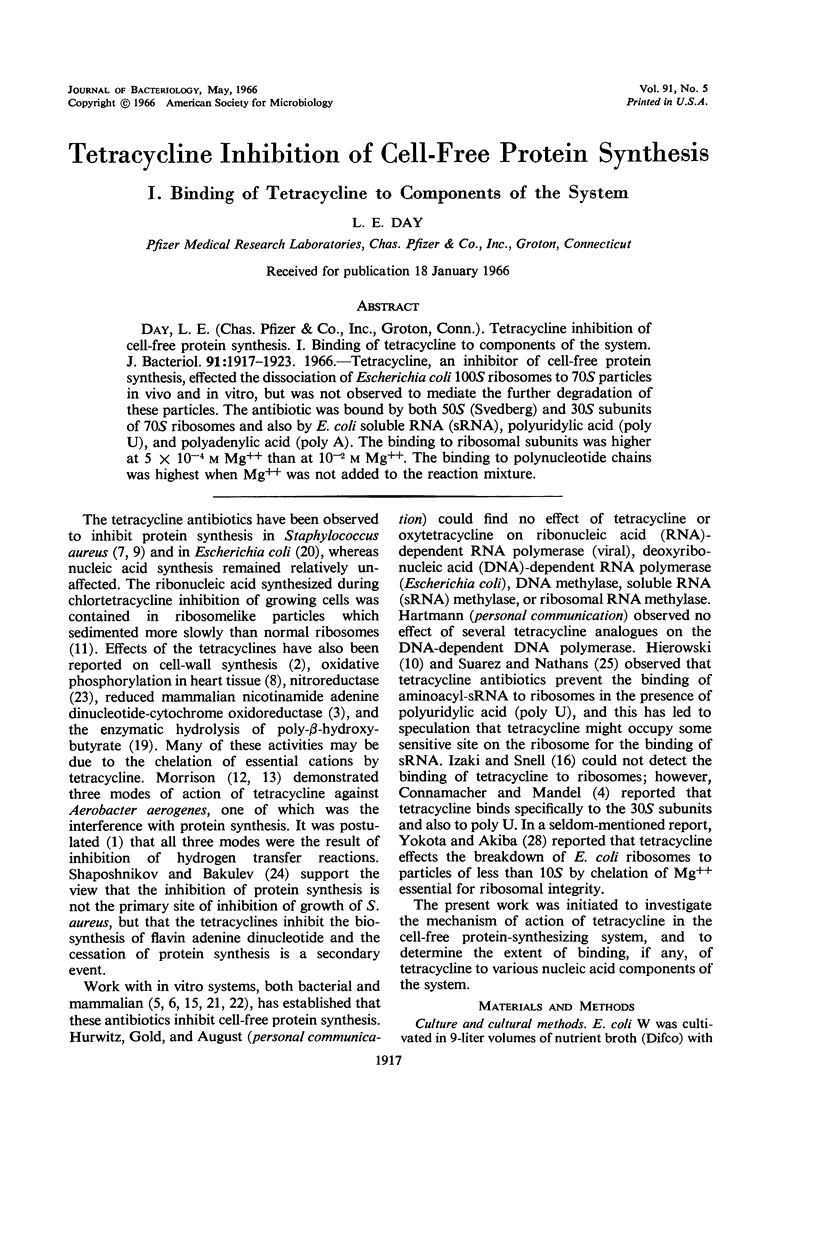
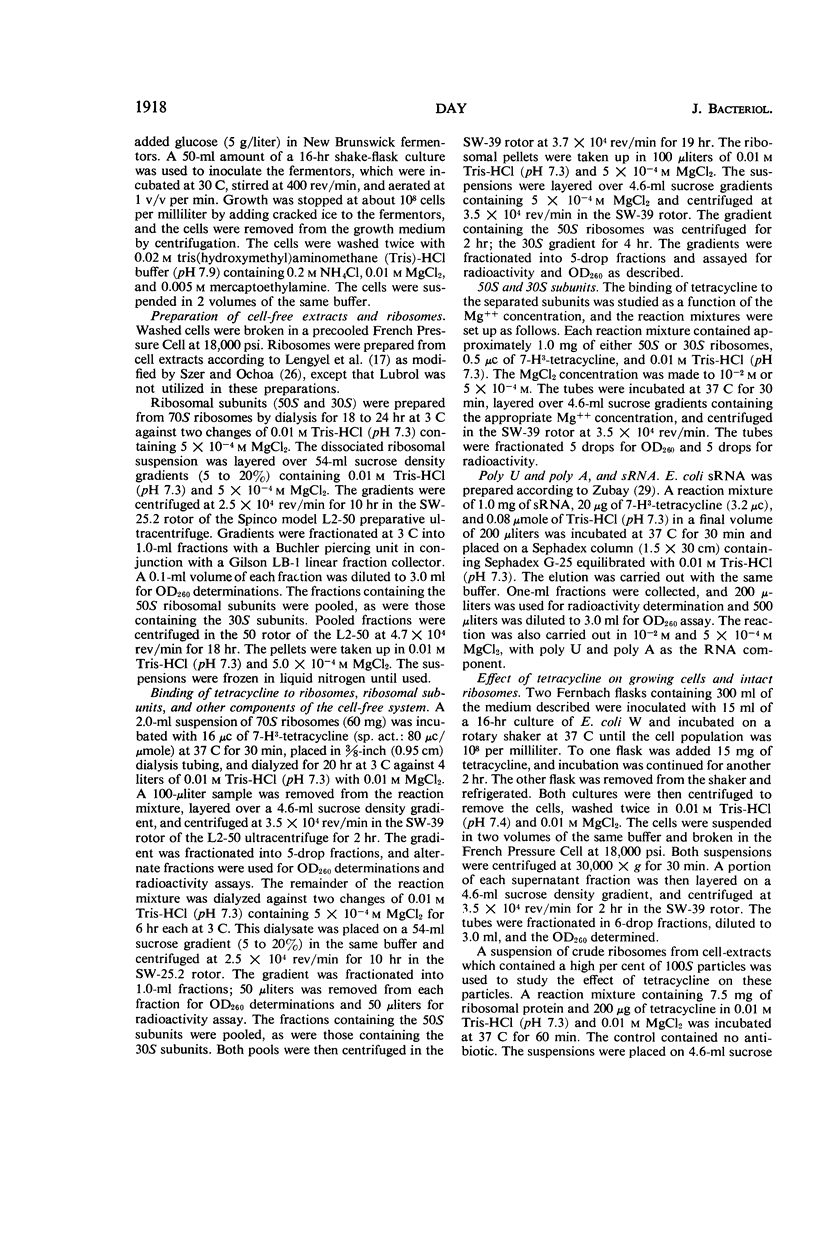
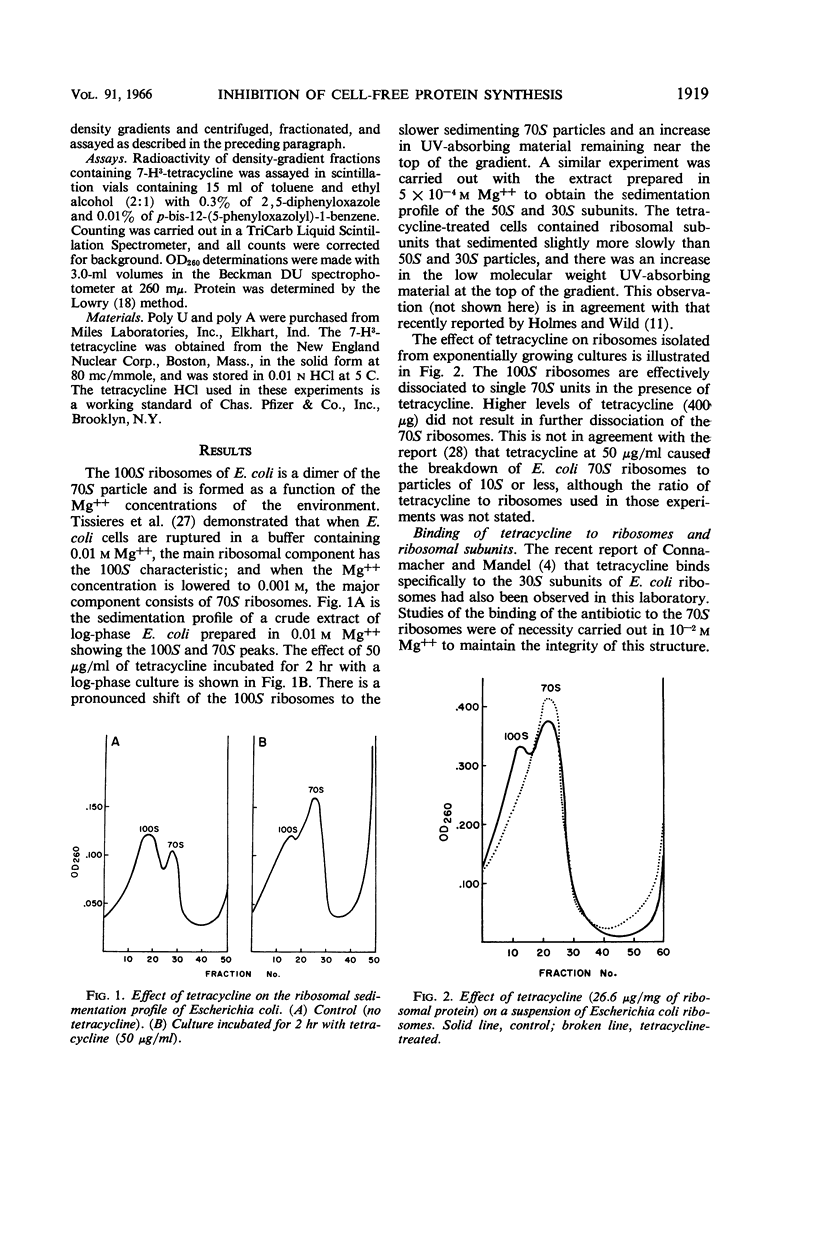
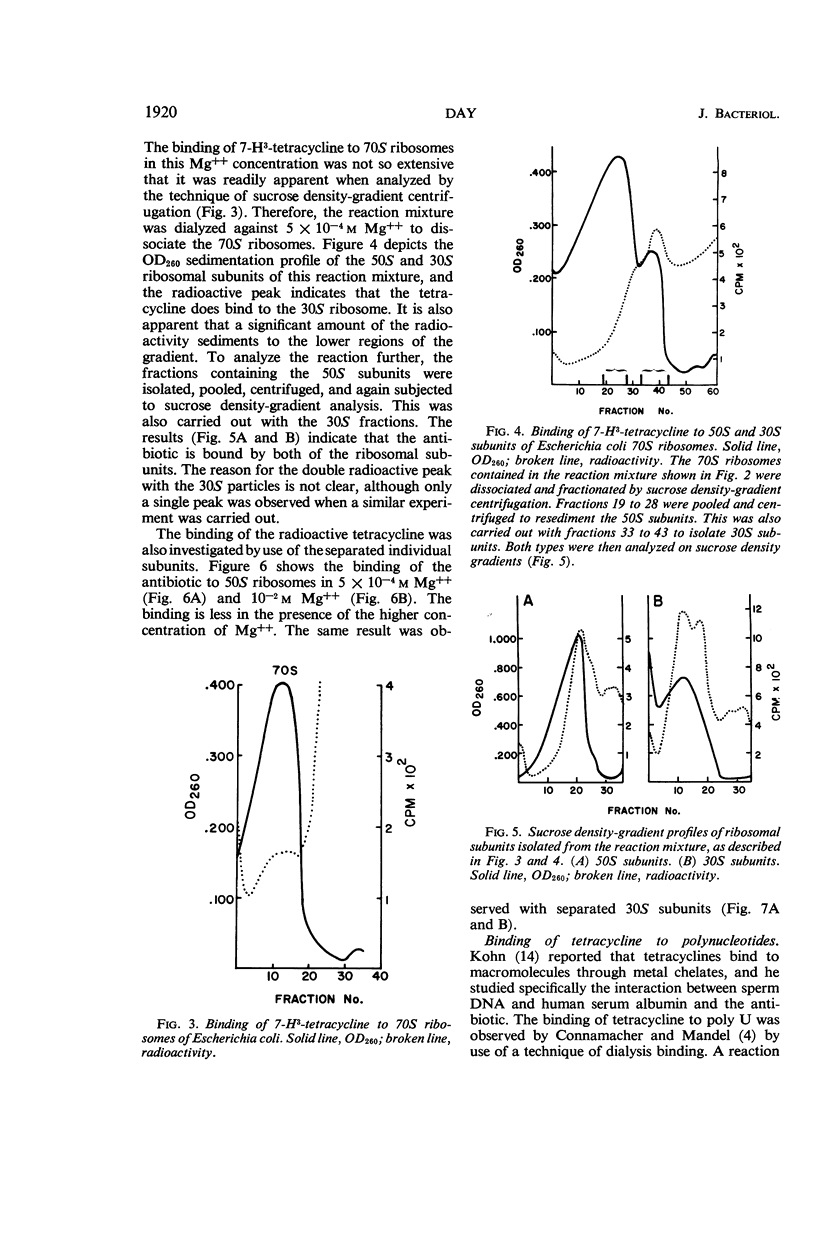
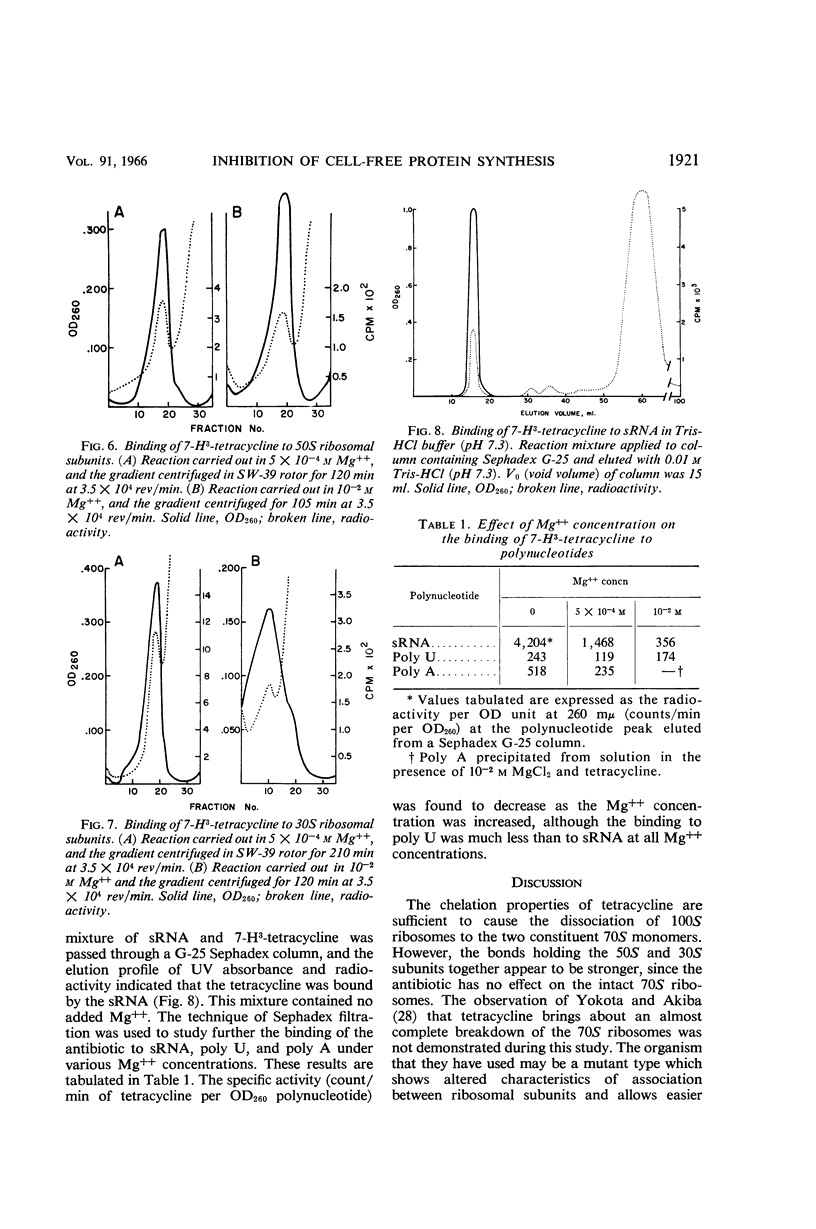
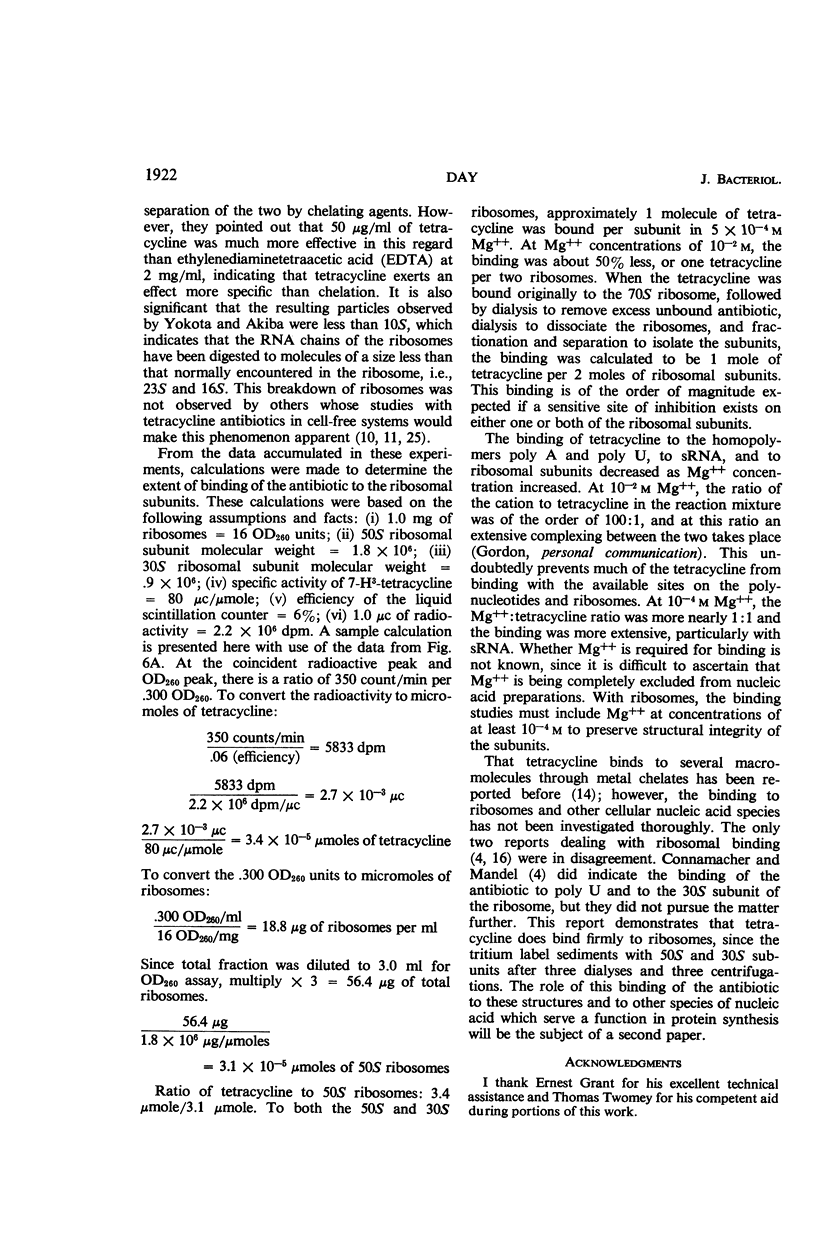

Selected References
These references are in PubMed. This may not be the complete list of references from this article.
- Benbough J., Morrison G. A. Bacteriostatic actions of some tetracyclines. J Pharm Pharmacol. 1965 Jul;17(7):409–422. doi: 10.1111/j.2042-7158.1965.tb07696.x. [DOI] [PubMed] [Google Scholar]
- CHENG L., SNELL J. F. Studies in metabolic spectra. IV. Effects of tetracyclines, some of their derivatives, and chloramphenicol on accumulation of glutamic acid in Escherichia coli. J Bacteriol. 1962 Apr;83:711–719. doi: 10.1128/jb.83.4.711-719.1962. [DOI] [PMC free article] [PubMed] [Google Scholar]
- CONNAMACHER R. H., MANDEL H. G. BINDING OF TETRACYCLINE TO THE 30S RIBOSOMES AND TO POLYURIDYLIC ACID. Biochem Biophys Res Commun. 1965 Jun 18;20:98–103. doi: 10.1016/0006-291x(65)90954-x. [DOI] [PubMed] [Google Scholar]
- Colaizzi J. L., Knevel A. M., Martin A. N. Biophysical study of the mode of action of the tetracycline antibiotics. Inhibition of metalloflavoenzyme NADH cytochrome oxidoreductase. J Pharm Sci. 1965 Oct;54(10):1425–1436. doi: 10.1002/jps.2600541006. [DOI] [PubMed] [Google Scholar]
- FRANKLIN T. J. The inhibition of incorporation of leucine into protein of cell-free systems from rat liver and Escherichia coli by chlortetracycline. Biochem J. 1963 Jun;87:449–453. doi: 10.1042/bj0870449. [DOI] [PMC free article] [PubMed] [Google Scholar]
- Franklin T. J. The effect of chlortetracycline on the transfer of leucine and 'transfer' ribonucleic acid to rat-liver ribosomes in vitro. Biochem J. 1964 Mar;90(3):624–628. doi: 10.1042/bj0900624. [DOI] [PMC free article] [PubMed] [Google Scholar]
- GALE E. F., FOLKES J. P. The assimilation of amino-acids by bacteria. XV. Actions of antibiotics on nucleic acid and protein synthesis in Staphylococcus aureus. Biochem J. 1953 Feb;53(3):493–498. doi: 10.1042/bj0530493. [DOI] [PMC free article] [PubMed] [Google Scholar]
- GOMAZKOV O. A. MECHANISM OF ACTION OF TETRACYCLINE ANTIBIOTICS. Fed Proc Transl Suppl. 1964 Jul-Aug;23:876–878. [PubMed] [Google Scholar]
- HASH J. H., WISHNICK M., MILLER P. A. ON THE MODE OF ACTION OF THE TETRACYCLINE ANTIBIOTICS IN STAPHYLOCOCCUS AUREUS. J Biol Chem. 1964 Jun;239:2070–2078. [PubMed] [Google Scholar]
- HIEROWSKI M. INHIBITION OF PROTEIN SYNTHESIS BY CHLORTETRACYCLINE IN THE E. COLI IN VITRO SYSTEM. Proc Natl Acad Sci U S A. 1965 Mar;53:594–599. doi: 10.1073/pnas.53.3.594. [DOI] [PMC free article] [PubMed] [Google Scholar]
- Holmes I. A., Wild D. G. The synthesis of ribonucleic acid during inhibition of Escherichia coli by chlortetracycline. Biochem J. 1965 Oct;97(1):277–283. doi: 10.1042/bj0970277. [DOI] [PMC free article] [PubMed] [Google Scholar]
- KOHN K. W. Mediation of divalent metal ions in the binding of tetracycline to macromolecules. Nature. 1961 Sep 16;191:1156–1158. doi: 10.1038/1911156a0. [DOI] [PubMed] [Google Scholar]
- LENGYEL P., SPEYER J. F., OCHOA S. Synthetic polynucleotides and the amino acid code. Proc Natl Acad Sci U S A. 1961 Dec 15;47:1936–1942. doi: 10.1073/pnas.47.12.1936. [DOI] [PMC free article] [PubMed] [Google Scholar]
- LOWRY O. H., ROSEBROUGH N. J., FARR A. L., RANDALL R. J. Protein measurement with the Folin phenol reagent. J Biol Chem. 1951 Nov;193(1):265–275. [PubMed] [Google Scholar]
- Laskin A. I., May Chan W. Inhibition by tetracyclines of polyuridylic acid directed phenylalanine incorporation in Escherichia coli cell-free systems. Biochem Biophys Res Commun. 1964;14:137–142. doi: 10.1016/0006-291x(64)90243-8. [DOI] [PubMed] [Google Scholar]
- Last J. A., Izaki K., Snell J. F. The failure of tetracycline to bind to Escherichia coli ribosomes. Biochim Biophys Acta. 1965 Jul 15;103(3):532–534. doi: 10.1016/0005-2787(65)90153-x. [DOI] [PubMed] [Google Scholar]
- Merrick J. M. Effect of polymyxin B, tyrocidine, gramicidin D, and other antibiotics on the enzymatic hydrolysis of poly-beta-hydroxybutyrate. J Bacteriol. 1965 Oct;90(4):965–969. doi: 10.1128/jb.90.4.965-969.1965. [DOI] [PMC free article] [PubMed] [Google Scholar]
- NAKAYA R., TREFFERS H. P. The growth rates and adaptive enzyme activities of chloramphenicol- and oxytetracycline-resistant Escherichia coli. Antibiot Annu. 1958;6:865–872. [PubMed] [Google Scholar]
- OKAMOTO S., MIZUNO D. MECHANISM OF CHLORAMPHENICOL AND TETRACYCLINE RESISTANCE IN ESCHERICHIA COLI. J Gen Microbiol. 1964 Apr;35:125–133. doi: 10.1099/00221287-35-1-125. [DOI] [PubMed] [Google Scholar]
- RENDI R., OCHOA S. Effect of chloramphenicol on protein synthesis in cell-free preparations of Escherichia coli. J Biol Chem. 1962 Dec;237:3711–3713. [PubMed] [Google Scholar]
- SZER W., OCHOA S. COMPLEXING ABILITY AND CODING PROPERTIES OF SYNTHETIC POLYNUCLEOTIDES. J Mol Biol. 1964 Jun;8:823–834. doi: 10.1016/s0022-2836(64)80163-7. [DOI] [PubMed] [Google Scholar]


